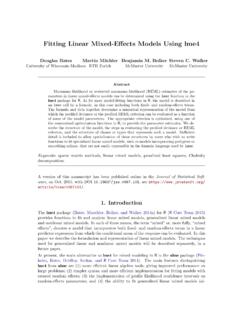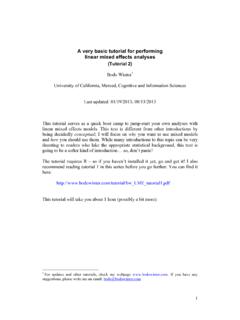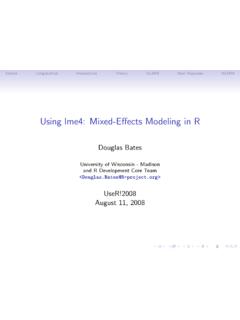Transcription of Introduction to Generalized Linear Mixed Models
1 1 Jerry W. Davis, University of Georgia, Griffin Campus. 2018. Introduction to Generalized Linear Mixed Models A Count Data Example Jerry W. Davis, University of Georgia, Griffin Campus Analysis of variance rests on three basic assumptions: response variables are normally distributed, individual observations are independent and the variances between experimental units are homogeneous. Data from agricultural experiments do not always follow these assumptions. Traditional analysis of variance techniques are very robust, so some deviation from these assumptions does not necessarily lead to erroneous results, and the Central Limit Theorem implies that data from experiments with many observations have means that are approximately normal.
2 Traditionally, transformations were used to normalize categorical response variables and minimize the effect of heterogeneous variances. In the 1990s and 2000s, advances in statistical methods and computing technology allowed analysts to model data from non-normal distributions in an analysis of variance framework. The distribution of the response variable is part of the model so the normality assumptions are unnecessary. These Models are called Generalized Linear Models because they extend Linear model theory to model categorical response variables. Finally, Mixed model theory was incorporated, which led to Generalized Linear Mixed Models . Analysis of Variance Models Linear Models (LM) are for normally distributed (Gaussian) data and only model fixed effects.
3 SAS (SAS/STAT Software, 2017) procedures reg, glm or anova fit these Models . Linear Mixed Models (LMM) are for normally distributed (Gaussian) data and can model random and / or repeated effects. The Mixed procedure fits these Models . Generalized Linear Models (GLM) are for non-normal data and only model fixed effects. SAS procedures logistic, genmod1 and others fit these Models . Generalized Linear Mixed Models (GLMM) are for normal or non-normal data and can model random and / or repeated effects. The glimmix procedure fits these Models . GLMM is the general model , with LM, LMM, and GLM being special cases of the Generalized model (Stroup, 2013). Distributions Selecting the proper distribution is key when fitting a Fortunately, there are guidelines to follow which match types of response data to known distributions.
4 Here are some common non-normal data types, their characteristics and distribution. 1 GENMOD can model repeated effects for some types of data. 2 Analysis of variance Models are referred to by their abbreviations. 2 Jerry W. Davis, University of Georgia, Griffin Campus. 2018. Counts. Count data comes from counting events of interest in an experimental unit. Counts are non-negative integers, often right skewed, with a Poisson or Negative Binomial distribution. Number of insects, weeds, diseased plants, etc., within each plot are common response variables. Count data is unbounded, , there are no predetermined limits imposed on the range of values.
5 For example, the number of flowers on a plant, cotton bolls per plant or number of insects in an area may have biological limits, but the limits are not predetermined. Whereas the number of plants in a plot that survived without water is bounded by the original number of plants in the plot. It is better to treat these counts as having a binomial distribution rather than a Poisson or negative binomial. Binomial. Binomial data are discrete positive integers between 0 and n. It is the standard distribution for the number of successes from n independent trials with only two outcomes. Usual outcomes are success or failure, 1 or 0, alive or dead, etc. Also called discrete proportions, example data include eggs hatched from the total number of eggs, seeds germinated from the total number of seeds or number of plants that survived without water from the total number of plants within a plot.
6 When n equals one, it is known as a Bernoulli trial. A coin toss is an example of a Bernoulli trial. Continuous proportions. These data are percentages that represent the proportion of affected subjects, areas, etc., within an experimental unit. These proportions have a Beta distribution. Example data include the percent of a plot with insect or disease infestation, damaged leaf area, lesion size as a percent, etc. Ratings and ranks. Subjective measurements based on a discrete scale or criteria. The scale may or may not be Linear . A Linear scale implies the difference between ratings is equal. With a non- Linear scale, the difference between one and two on a six-point scale; for example, is not equal to the difference between five and six.
7 These data follow a Multinomial distribution. Example data include disease ratings, sensory evaluations, herbicide efficacy ratings, etc. Multinomial response data need not be numeric; proc glimmix will analyze data consisting of either numeric or character ratings. Poisson and Negative Binomial Distributions For a Poisson distribution the mean equals the variance ( = ). This relationship implies that the events are randomly and evenly distributed within the experimental units. This is often an unrealistic assumption for agricultural data where events, such as insect outbreaks or patches of weeds, may be clustered with much variability between plots. When this happens, the variance may be larger than the mean.
8 This condition is called over-dispersion. Over-dispersion may affect the fit and results of a GLMM so remedial steps are recommended to alleviate the problem. The data are under-dispersed when the variance is smaller than the mean. The negative binomial distribution is similar to the Poisson except it has an additional parameter called a scale parameter. The scale parameter ( ) allows the variance to be larger (or smaller) than the mean 3 Jerry W. Davis, University of Georgia, Griffin Campus. 2018. and may reduce or remedy the over-dispersion problem. Some argue that the negative binomial should always be used for agricultural data while others disagree. Pseudo-likelihoods Like Linear Mixed Models , Generalized Linear Mixed Models use maximum likelihood techniques to estimate model parameters.
9 The default estimation technique for proc glimmix is residual pseudo likelihood (RSPL) when the data are non-normal. However, RSPL does not produce a true log-likelihood when modeling non-normal data. It can only calculate a quasi or pseudo-likelihood. This affects the model in several ways. The model is not conditioned by the random effects. This may affect tests for the fixed effects and LS-means. Only a conditional model has the correct fit statistics for diagnosing over-dispersion. (Gbur et al, 2012). The information criterions (AIC, AICC, BIC, etc.), which are important for assessing the relative goodness of fit, cannot be calculated. Changing the estimation method to adaptive quadrature (quad) or Laplace will solve these problems by fitting a true log-likelihood function.
10 Therefore, when fitting count data, use method=quad or method=laplace to minimize the log likelihood function. Adaptive quadrature and Laplace methods have side effects as well. Some common ones are. The ddfm options kr2 or satterthwaite are not available. Letting ddfm default to the containment method by omitting the ddfm option is acceptable. When using method=quad, random effects must be processed by subjects. For example, if a model has block as a random effect , random block will generate an error message. The correct syntax is, random intercept / subject=block. If there are two random effects, such as block and year, both affects must appear in the same random statement , random intercept / subject=block*year.
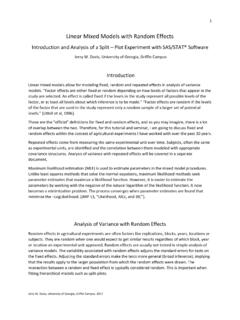

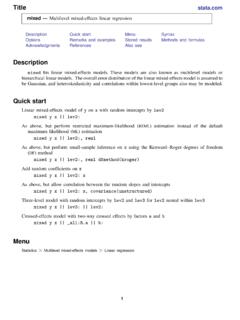
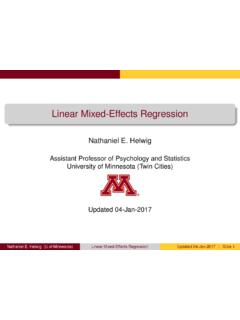
![[ME] Multilevel Mixed Effects - Stata](/cache/preview/4/7/d/4/7/0/c/8/thumb-47d470c861983dd93e6de78ee5724463.jpg)
